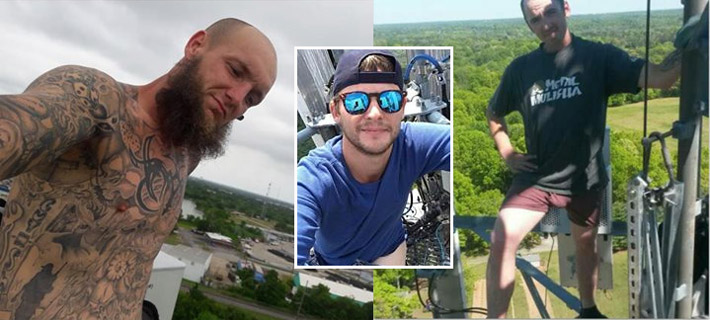
Facebook pages provide an uncensored opportunity for stupidity
June 5, 2019 – For over a dozen years Wireless Estimator has highlighted some of the most egregious tower climber safety infractions in its Tower Climbers Hall of Shame. Almost daily you could view violations on Facebook.
Thankfully, most Facebook group moderators took the high road and now delete troubling photos.
But where there’s a desire for willful violations there’s a way, and it has become vogue for climbers to post their photos on their own page, such as the three above that were sent to Wireless Estimator this week.
Why these men are taking these risks is beyond comprehension. It disrespects the nation’s proud professionals whose mantra is 100% tie off – always. Climbers that will never have to worry about their supervisor delivering a dreaded message to their family that their loved one fell to his or her death.
Newest Hall of Shame tech should be severely disciplined by his employer
The message is clear, 100% tie-off at all times. The message that you shouldn’t allow someone to be climbing a tower without adequate PPE, training and supervision is even clearer, especially since a 28-year-old Texas woman died last.jpg) March after her boyfriend took her on a test climb on a site where he had no authorization to be and she fell and died. But a tower technician didn’t get the message and posted a similar photo on social media with his girlfriend in her petulant pose, open-toed sandals, no hard hat, and tight shorts.
March after her boyfriend took her on a test climb on a site where he had no authorization to be and she fell and died. But a tower technician didn’t get the message and posted a similar photo on social media with his girlfriend in her petulant pose, open-toed sandals, no hard hat, and tight shorts.
The twosome will go into Wireless Estimator’s Hall of Shame and the article will likely be redistributed to hiring personnel to ensure that they know that the man is incapable of getting the all-important communication that working aloft is serious business.
And if viewers know where he is presently working, they should let the tech’s employer know about his employee’s total disregard for safety.
Frequently on Facebook and other social media the industry can witness climbing and rigging infractions that cause one to nod in disbelief; this photograph, however, has every professional worker’s head spinning like a drunken dreidel.
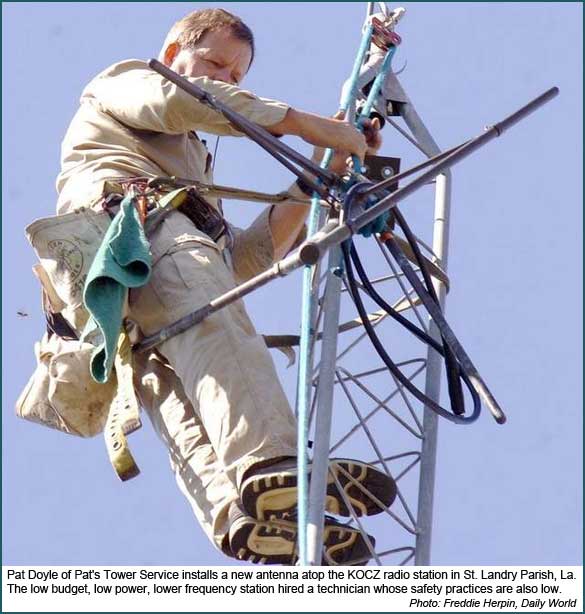
Having your pedicurist galvanize your toenails won’t save you from OSHA
Advertising agencies and marketing personnel have a singular mindset: use an appealing graphic accompanied by a clever turn of phrase or a 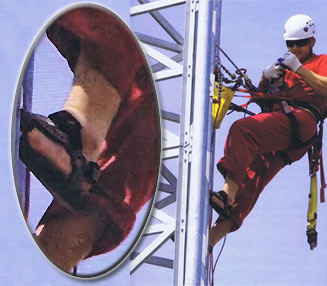 message that resonates with and motivates their audience. And sometimes they step on their toes. In a full page ad in the 2013 PCIA show program and directory a software company published an excellent graphic of a tower technician hard at work at his craft high above the skyline.
message that resonates with and motivates their audience. And sometimes they step on their toes. In a full page ad in the 2013 PCIA show program and directory a software company published an excellent graphic of a tower technician hard at work at his craft high above the skyline.
Unfortunately, he wasn’t wearing steel-toe boots or any footwear that would protect his toes as he fashionably sported sandals, perhaps to tie into the Hollywood, Fla. oceanfront conference atmosphere.
And it appears that he has pulled his annoying shoulder straps behind him to enjoy a comfortable break with a V8 or whatever he’s getting ready to uncap.
It is not known if the advertiser had been alerted to the safety faux pas and hired tiger teams to sketch in Red Wing boots and straps in approximately 2,000 programs.
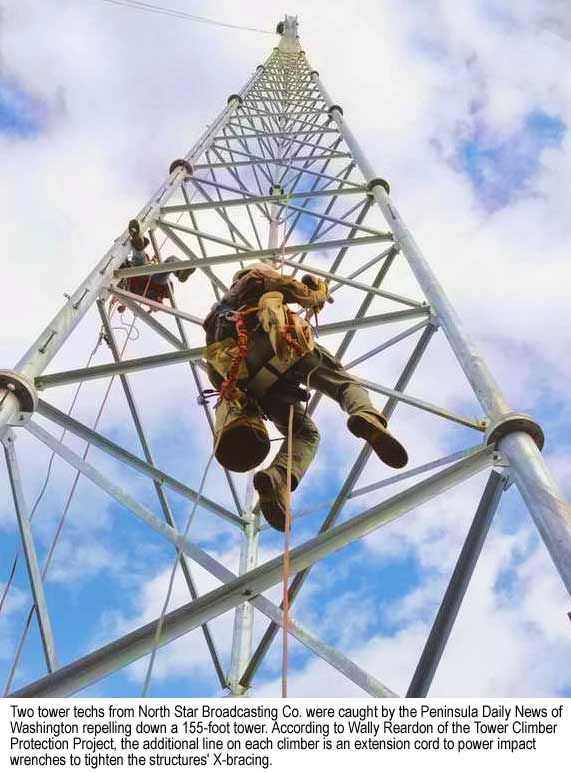
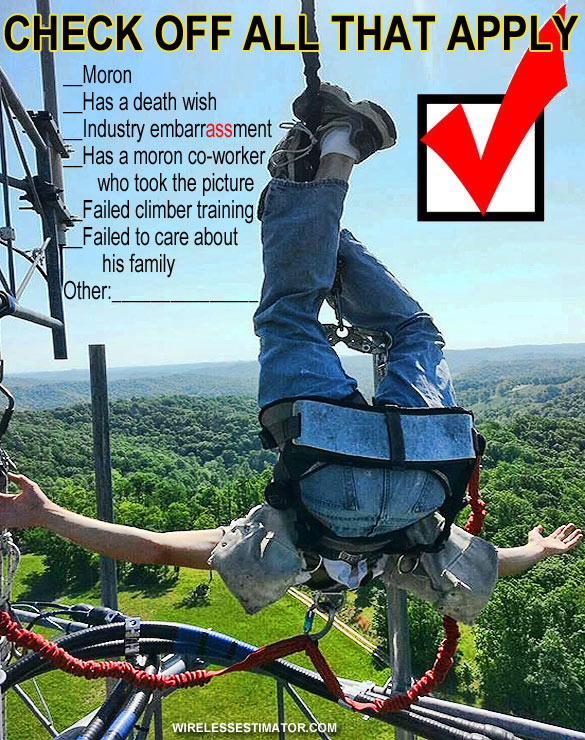
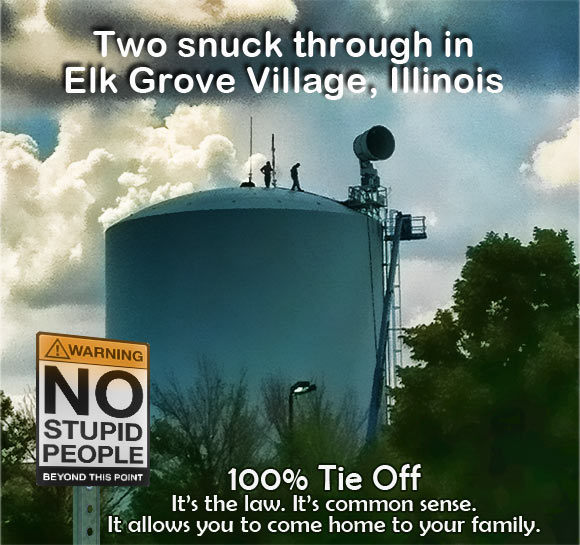
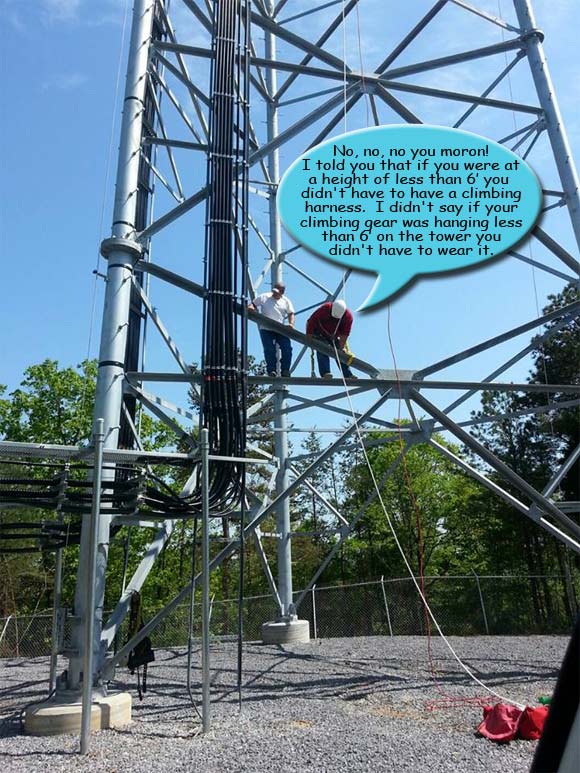
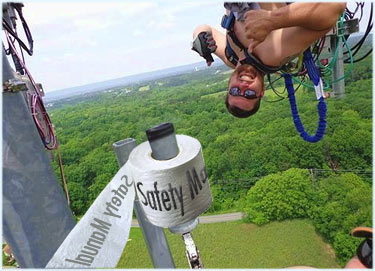
Here’s what he thinks of his employer’s safety manual and work requirements
Safety directors spend untold hours and many thousands of dollars to ensure that their employees are provided a safe work environment. And then some workers treat their efforts like…well, S%#!
Pride in photographing unsafe practices indicates
the industry still has a long way to go
Commentary
June 10, 2013 – Two testosterone-pumped tower techs proudly flexed their muscles on a T-arm last week in a Facebook photo in an  embarrassing disregard for safe working practices. The two men were photographed on the end of an antenna mounting frame with one of the techs inverted underneath the other – appearing as tritely-captioned refrigerator magnets on a sliver of life support, stating: Stupid is as Stupid does. Greenhorns know that you don’t tie off to an antenna mounting frame because they’re not man-rated, especially not two-man-rated.
embarrassing disregard for safe working practices. The two men were photographed on the end of an antenna mounting frame with one of the techs inverted underneath the other – appearing as tritely-captioned refrigerator magnets on a sliver of life support, stating: Stupid is as Stupid does. Greenhorns know that you don’t tie off to an antenna mounting frame because they’re not man-rated, especially not two-man-rated.
The Facebook photograph is disturbing inasmuch as a number of its associated comments said it was an awesome picture and one tower tech was upset that he hadn’t thought of doing something like dumb and dumber did.
Another viewer commented that the industry should get a grip and the picture police should back off.
Why didn’t the techs’ co-workers immediately stop the photo staging being taken by a third elevated worker?
These techs weren’t reportedly working for the usually maligned Bubba’s Truck and Rope Company, or for one of the newly formed enterprises seeking LTE projects, but for a long-established mid-sized company which heralds its stringent safety policies.
It appears that this company needs to strive for a greater workforce involvement in safety, as do others in this industry.
It’s apparent that in the rush to build out LTE, stupidity is not a handicap. It’s just deadly.
Tying off is only valuable if it is performed correctly, not as practiced by a Florida tower crew
December 4, 2012 – Idioms such as Tie off or fly off are industry catchphrases that have focused upon workers’ needs to stay 100% tied off on towers or other structures, 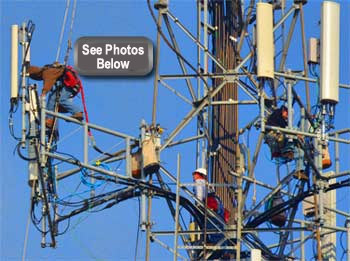 but their simplicity could be misleading.
but their simplicity could be misleading.
As this photograph shows, three crew members working in Bartow, Fla. for a major carrier on a major tower owner’s structure last week should be partly commended for tying off.
The commendation, however, must be accompanied with a failing grade for how they were trained and/or an admonishment for how they are allowed to do it. The tower technician standing on the mounting frame on the left displays a number of safety issues. Although his fall protection lanyard is the maximum allowable length of six feet, he has added what appears to be an additional four-foot, possibly longer, lanyard to reach the antennas.That violation is compounded by wrapping it around the top of a clamp set which has the potential to cut the sling in the event of a fall when it is impact loaded, according to John Paul Jones, Vice President of Training for Safety LMS.
Although he couldn’t identify if it was an appropriate life safety sling, he noted that the choked connection de-rated the sling’s capacity by at least 25 percent.
Because he is standing on the mounting frame, the technician could possibly fall approximately 26 feet, landing on the sector mount below.
His co-worker, standing behind the waveguide ladder, has his fall arrest lanyard connected to a six-foot nylon positioning lanyard which is choked back around the horizontal angle brace which could cut it upon a fall.
The other end is connected to the large hook on the end of one leg of the tech’s fall arrest lanyard.
This is an incompatible connection, said Jones, and increases the total fall distance.
The technician working to his right has one leg of his positioning lanyard wrapped in a choked configuration around his tie off point. His fall arrest lanyard is connected to the tower leg which is not visible but it might be presumed that he shares the same bad habits as his crew members.
It would be too dangerous for a tower crew to stage these serious infractions, but sometimes life imitates the art of providing a poster perfect tailgate session.
The Florida contractor was notified by WirelessEstimator.com about these safety violations.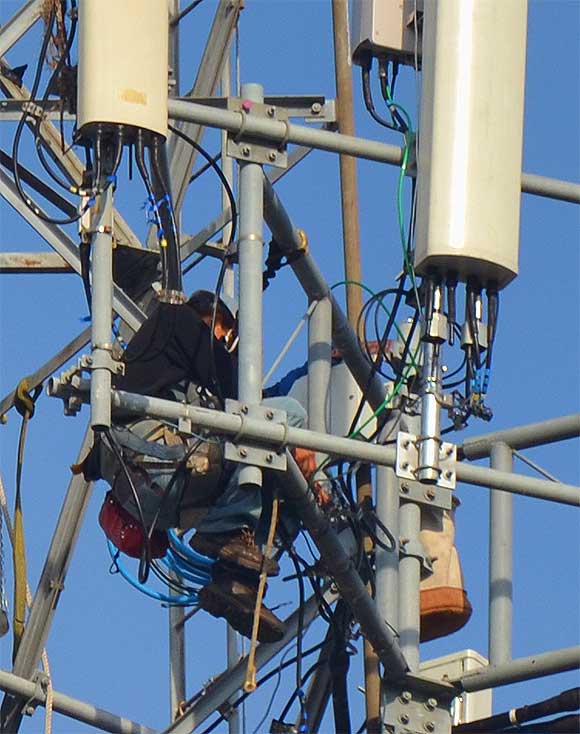
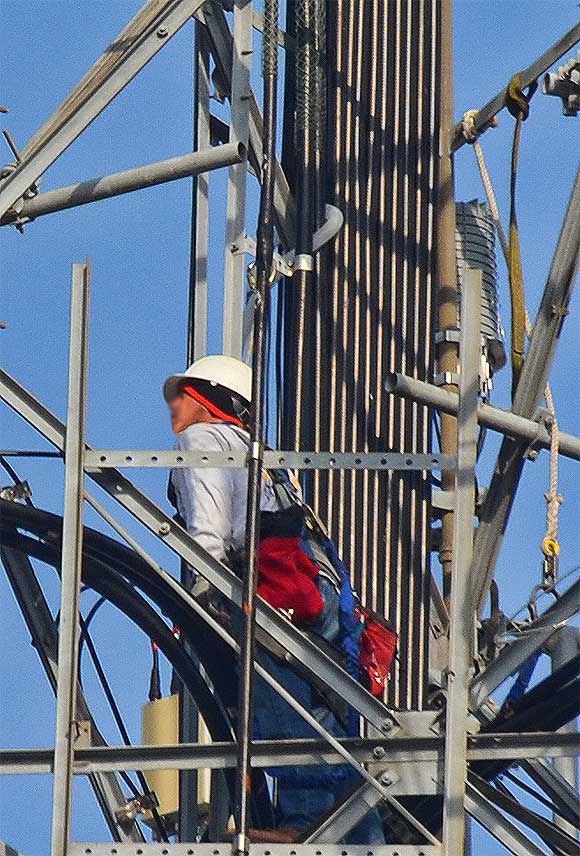
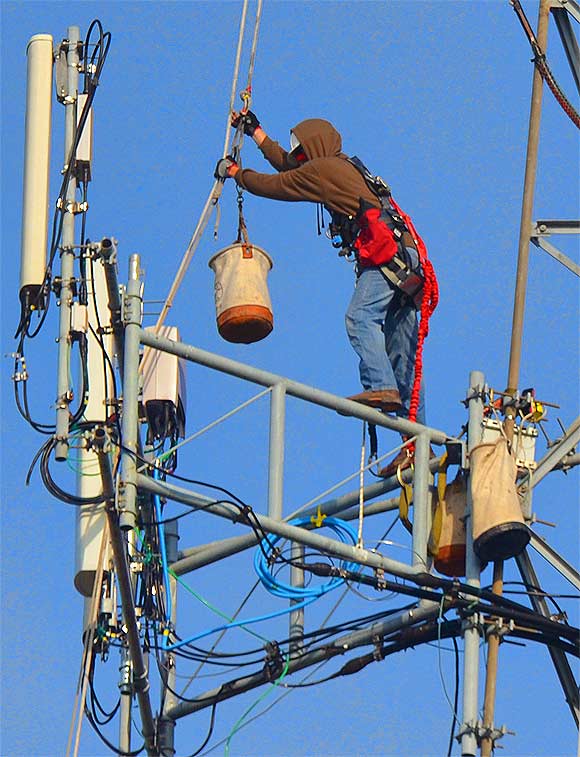
Millions being told free climbing is okay
September 17, 2010 – A new online site for broadcast engineers that says it “expertly informs, educates and shares useful information,” didn’t rise to that task this week when it provided a seven-minute video of two lighting technicians free climbing at the top of a 1,768-foot broadcast tower.
The narrated video produced by TheOnLineEngineer.org, entitled “Stairway to Heaven,” was presented in an instructional mode explaining the exacting procedures for climbing a communications structure.
Unfortunately, the tower technicians were free climbing and the narrator had no knowledge about fall protection standards, stating that in regards to free climbing, “…it’s easier, faster and most tower workers climb this way. Free climbing is more dangerous, of course, but OSHA rules do allow for it.”
Jim Coleman, Chairman of the National Association of Tower Erectors viewed the video this morning on YouTube and was troubled by the comments concerning free climbing. He was also concerned that it was entitled as a tutorial.
| Commentary: DO BROADCASTERS TAKE SAFETY SERIOUSLY? The viral tower climbing video is expected to be one of America’s most viewed videos and professionals are taking  every opportunity to denounce the climbers and the producer of the tutorial for their blatant violations of proper climbing safety procedures. Although the National Association of Tower Erectors pursues every opportunity it can to ensure that broadcasters fully understand the need to hire professionals, and the resulting problems in liability and poor quality installations if they don’t, the broadcast industry trade associations and media do not take an active role in promoting climber safety. The recent video has been largely ignored by broadcasters, and in one instance where there was a tongue in cheek piece that didn’t criticize free climbing, it ostensibly extolled the practice as being acceptable – sort of like You know how those tower guys are! Wink, wink! An editor of the Radio and Television Business Report, the country’s leading voice of the broadcast industry, placed a copy of the video on its web site that was sent to them from engineer Jerry Smith. Instead of a broad brush condemnation of the practice of free climbing, the article said that “climbers are a breed apart.” After Smith joked about the similarities of falling from a 1,700-foot tower and one at 200 feet, he said the free climbing technician’s lack of concern about his safety was somehow analogous to “why we prefer not riding in the car of a tower climber and don’t mind paying them to do the lamp replacements.” Ironically, the producer of the video said on his blog today that the climber in a video that appears to be this one was an engineer. If that’s the case, many industry folks have probably been in a car driven by an engineer during their career. Possibly with Mr. Smith. It’s amazing how we ever survived! Perhaps it’s because we followed the law and buckled up. The editor described the video as “the real deal, as viewed by a helmet cam.” It’s a raw deal for those who take safety seriously. every opportunity to denounce the climbers and the producer of the tutorial for their blatant violations of proper climbing safety procedures. Although the National Association of Tower Erectors pursues every opportunity it can to ensure that broadcasters fully understand the need to hire professionals, and the resulting problems in liability and poor quality installations if they don’t, the broadcast industry trade associations and media do not take an active role in promoting climber safety. The recent video has been largely ignored by broadcasters, and in one instance where there was a tongue in cheek piece that didn’t criticize free climbing, it ostensibly extolled the practice as being acceptable – sort of like You know how those tower guys are! Wink, wink! An editor of the Radio and Television Business Report, the country’s leading voice of the broadcast industry, placed a copy of the video on its web site that was sent to them from engineer Jerry Smith. Instead of a broad brush condemnation of the practice of free climbing, the article said that “climbers are a breed apart.” After Smith joked about the similarities of falling from a 1,700-foot tower and one at 200 feet, he said the free climbing technician’s lack of concern about his safety was somehow analogous to “why we prefer not riding in the car of a tower climber and don’t mind paying them to do the lamp replacements.” Ironically, the producer of the video said on his blog today that the climber in a video that appears to be this one was an engineer. If that’s the case, many industry folks have probably been in a car driven by an engineer during their career. Possibly with Mr. Smith. It’s amazing how we ever survived! Perhaps it’s because we followed the law and buckled up. The editor described the video as “the real deal, as viewed by a helmet cam.” It’s a raw deal for those who take safety seriously.— CEL |
“I’m unaware of any guidance by OSHA that allows for free climbing as an acceptable method of accessing elevated work,” Coleman said.
The video first appeared on The On Line Engineer’s web site, but the man that shot it using a helmet camera, and who approved the edited version, said “he was getting calls from colleagues telling him that they were concerned about what the video showed,” according to the web site’s owner, Russ Brown. It was removed due to Brown’s concern for his friend who provided the climbing footage. However, the video had been uploaded on YouTube on September 13 from someone who downloaded it from Brown’s site. It instantly went viral, registering over a quarter million views by September 15, as well as thousands of viewer comments.
Brown was immediately informed by the unnamed climber that it was on YouTube, and in his blog he said it took him two days to get YouTube to take off the copyrighted video that blurred out the second climber’s face.
But the free climbing video has been copied a number of times and keeps popping up on YouTube and social network sites, with one YouTube site showing nearly an additional 100,000 views prior to it too being removed.
However, the video keeps surfacing and one Yahoo video will be eclipsing over 750,000 viewers today.
The video has become a hot topic on forums, from one of the nation’s largest poker web sites to a travel forum.
Although professional tower technicians understand the need to observe 100% fall protection while climbing at a height of six feet or more, the impression the video gives is that the sole attributes one needs to be employed is the ability to be fit and fearless.
One commenter on Brown’s site wrote: “Wow! What an amazing video! I had no idea they free soloed when climbing. How do (you) train for this job?”
Brown did not return a request to be interviewed.
On his blog on August 28 he wrote: “The work at Sutro went smoothly, Peter Eckmann and his assistant worked quickly and put in the new probe section and got everyone back on the main antenna.”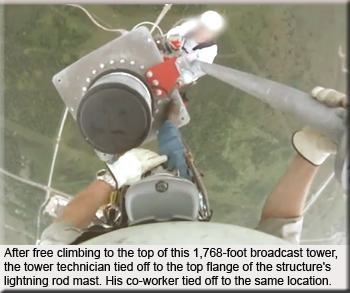
“Later on Peter showed me a video of him working on top of a 2000 foot tower in Texas. He was wearing a helmet camera and the views were out of this world with Peter looking down 2000 feet then up and you can see for 20 miles to the horizon.”
“Stay tuned as we may be getting that video right here on TheOnLineEngineer.Org in the near future,” he wrote.
It is not known whether Brown was referring to the video he posted on his site of the two men climbing, one with a headcam.
After free climbing to the top of the tower, the tower technician tied off to the top of the structure’s lightning rod mast. His co-worker tied off to the same location.
Brown said he had two offers to broadcast his video and had a request to submit it to a film festival in France. He also said that one of the reasons he took it off his site and petitioned YouTube to do the same is because “Some facility owners are pretty uptight about liability.”
He is extremely proud of the current video’s internet success, stating that he was going to develop more videos about tower climbing in conjunction with the free climbing star of his first venture.
“This was all much more than we had ever planned for or thought would happen,” he said on his blog.
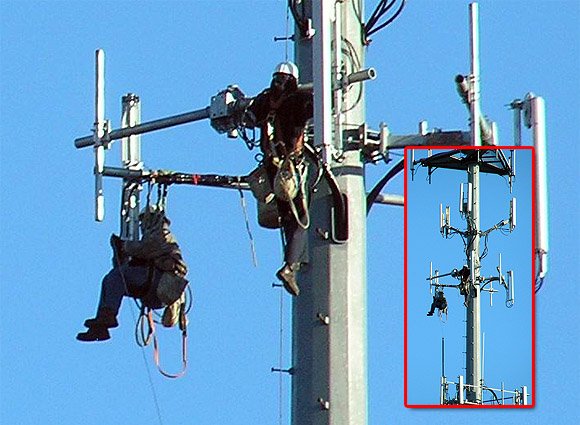
ARMS FOR THE POORLY INFORMED – Evidently, this crew doesn’t care about the advice given to the industry by AT&T Wireless during their stand down or they’re not fond of reading the many articles that discuss the failures on T-Arms which are not man-rated. The technician on the left does not have any safety connection back to the structure for added safety. The tech on the right has his safety tied back to the collar for the arms.This photo was taken October 18, 2008 at a structure located at a safety complex in Southern New Hampshire which houses the police, fire and ambulance squads for the community – organizations these techs are desperately trying to mobilize. Their pickup truck was not a commercial vehicle with any company identification.
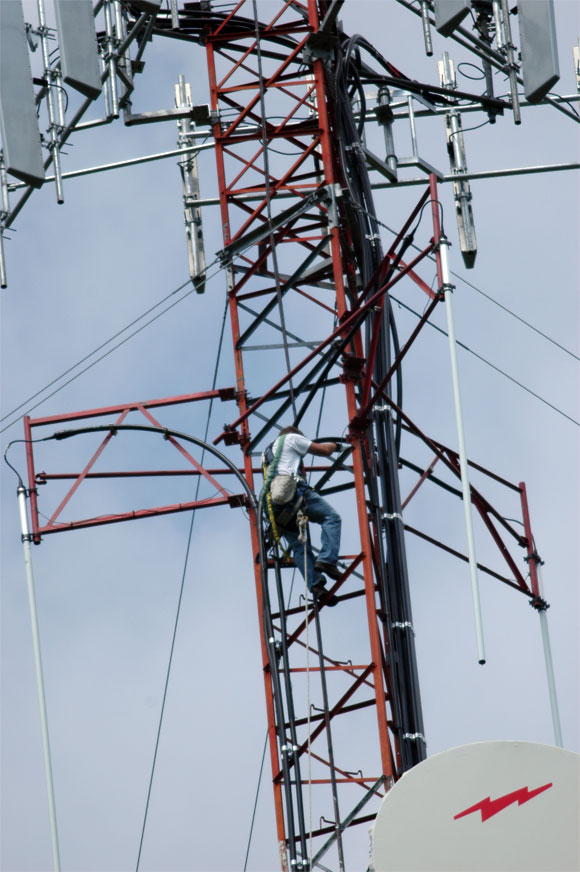
SMILE FOR THE CAMERA SINCE YOU WILL NOT BE ABLE TO FOR YOUR MORGUE PHOTO – This photograph was taken in upstate New York by a retired tower technician who said that he is still concerned about the number of people that do not tie off. He said that two men on the tower noticed that he was photographing them, but they continued to cavalierly free climb on the carrier-owned site.
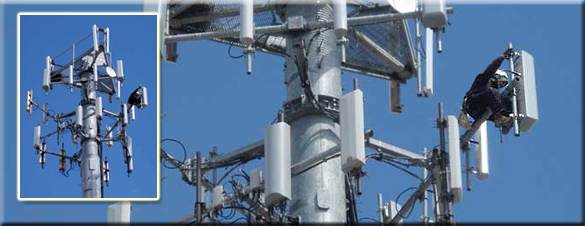
HIS IQ MUST BE EQUIVALENT TO HIS NECK SIZE, says the viewer who sent WirelessEstimator.com this picture that was taken in the vicinity of Tampa, FL. Neither the tower technician’s name nor the company he was employed by is known, but the climber is a poster child for a small number of climbers that ignore safe climbing procedures in an industry that is inherently safe when 100% fall protection is observed. We’re hoping that this climber has the ability to read, therefore, please note: You must have the equipment necessary and the knowledge required to observe 100% fall protection. Also, many T-arms are not man-rated and antenna mounts are prone to spinning.
If you see any climber actions that should be brought to the attention of the industry, please let us know. All replies will be confidential. Send your photographs and comments surrounding the unsafe practices to info@wirelessestimator.com.

















